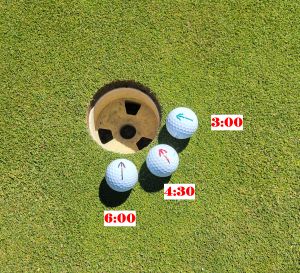March 8, 2022
What Kind of Putter are You? Part 2
A few weeks ago I posed the question to what kind of putter you are. Were you a Ben Crenshaw, Dave Stockton, or an Arnold Palmer type putter? The first is a die it in the hole style, the second a more aggressive 12 to 18 inch by the cup putter, or the last a bold charge it in the hole type. Each category presents different strategies in reading a putt and how to execute it properly. However, to be a really good putter, you have to have many styles of putting and know when to utilize them.
Mainly there are three types of putts; level, downhill, and uphill and then a mix of the three types based on slope.
 A downhill putt takes longer to reach the hole than an uphill putt. When judging the break you want to play, you should evaluate there the fall line is. Fall line is where the high point of the hole is located, or another way of looking at this, it is where water would drain if it were poured on the green. A putt on the fall line is a straight putt. Look at the where you want the ball to enter the hole. Note that is NOT the center of the cup. If you are looking at the hole like a clock, the center entry point would be 6 o'clock, while on a breaking that moves right to left putt, the entry point might be at 4:30 or as much a 3:00 o'clock. On a significant downhill putt the best strategy is the get the right speed to leave the putt at the hole. If there is a major break on a substantial downhill putt, try to get the ball to the fall line and let gravity take it from there. Worst mistake would be to under play the break. If you are undecided always favor playing more break. A wise golf professional once said, "the ball won't break uphill."
A downhill putt takes longer to reach the hole than an uphill putt. When judging the break you want to play, you should evaluate there the fall line is. Fall line is where the high point of the hole is located, or another way of looking at this, it is where water would drain if it were poured on the green. A putt on the fall line is a straight putt. Look at the where you want the ball to enter the hole. Note that is NOT the center of the cup. If you are looking at the hole like a clock, the center entry point would be 6 o'clock, while on a breaking that moves right to left putt, the entry point might be at 4:30 or as much a 3:00 o'clock. On a significant downhill putt the best strategy is the get the right speed to leave the putt at the hole. If there is a major break on a substantial downhill putt, try to get the ball to the fall line and let gravity take it from there. Worst mistake would be to under play the break. If you are undecided always favor playing more break. A wise golf professional once said, "the ball won't break uphill."
If we had a straight forward level putt, the strategy is also straight forward to your chosen style. But if we introduce a significant slope to this level putt, our calculations should change. Let's say the putt has a slope of over 3 degrees. The first part of the putt will actually be going up the slope and will have resistance for about 75% of its length. Once the putt has reached its apex (high point of the break) the ball will then turn towards the hole and will be going down the slope. Therefore, the first part of this putt must be aggressive at first and then with a light touch at the end. The mix will be Palmer first and Crenshaw touch at the end.
The uphill putt should be the easiest to figure break and speed. Because the putt needs a firm strike, the putt will take the shortest time to get to the hole. Also, because it is uphill there is a kind of backstop behind the hole to prevent the ball to go way past. This putt should be played aggressively with the intention to always get the ball past the hole. Think of yourself as a semi-Palmer putter on these obviously noticeable uphill putts. Putts coming uphill from right to left and breaking are usually in the 5:00 to 4:30 o'clock entry point.
When there is a combination of uphill, downhill and slope, the best way to judge what approach you should use is look at the last 25% of the putt, which is usually from 3 to 6 feet from the cup. If it is sloping away, be careful and consider the whole putt as a downhill putt concentrating on the speed at the hole. Dying it in or a little past is your objective. If it is level by the cup then the 12 to 18 inches by tactic applies. Uphill at the cup, you can be more aggressive, with less break and firm.
So you really are not just one type of putter, but all these great putters rolled into one, you just have to know when to use them.
Next will be a discussion on developing the correct speed.



